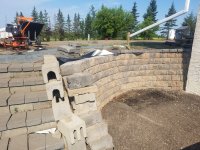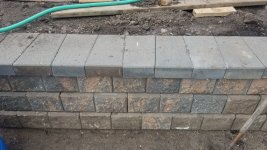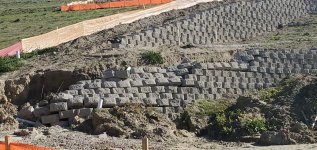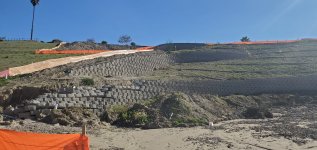As a home inspector,I see a lot of failing retaining walls. My advice is to try to have your top ground layers made with clay that slows the water absorbsion somewhat. Topsoil on top will soak in the rain but the clay will transport the water toward the wall, assuming you have the slope towards the wall. Make sure your clay later transports the water over the wall and not behind it. It's been my experience in this area that the wall can act as a dam and the whole hill behind the wall becomes saturated and puts pressure on the wall. A drainage plane is a great idea but if it plugs up you don't know. Allowing the ground water to flow over the wall reduces pressure on the wall by keeping the hill dryer. I also used pl premium to glue the blocks together.
You are using an out of date browser. It may not display this or other websites correctly.
You should upgrade or use an alternative browser.
You should upgrade or use an alternative browser.
Who knows about stacked-block retaining walls?
- Thread starter Sodo
- Start date
- Views: 28840
More options
Who Replied?
/ Who knows about stacked-block retaining walls?
#31
aircommuter
Platinum Member
- Joined
- Nov 26, 2012
- Messages
- 681
- Location
- coulterville,ca
- Tractor
- case 570lxt, JCB 1550B, Gradall 534c, Hyster C612B,Ford 445A
There are walls like that, question is how good is the compaction as it is built. There is also a wall like that known as Hilfiker which is wire. He is putting a wall over a wall. Probably should have started differently way before now. I agree about the trees they should also have been removed long ago. Sorry.It seems like you're using the fabric to keep the dirt back. I believe it's intended to hold the wall in place, with the backfill being securely compacted in layers. That said, I don't think those blocks are designed for a wall tall enough to require geotextile fabric.

Retaining walls and patio
Over at my brother's house he has some soil erosion going on and desires a more aesthetically pleasing hillside. His house sits above the street so our plan is to run a long wall on the hillside as well as a three-tier wall in front of the house. He also wants to replace his old backyard patio...
One of the most physically grueling projects I've done.
The blocks we used were designed to use pins and engineered geotextile fabric at specific levels. The fabric is supposed to anchor the wall into the hillside by laying it flat and integrating with the paver courses at different levels based on the height of the wall.
A crushed rock footing (12" or maybe more), wrapped drainage pipe, and crushed rock backfill all the way to the top course (with then 3-6" of dirt topsoil) will give you more longevity.
So far the wall we did is about four years old and so holding up well. We've had some record-breaking rains in that period that the wall stood up to. The drainage system works well in that after the rains, the drain pipe at the end will be flowing water and we don't see any gushing out the front of the blocks.
As others have said, without drainage that water is going to find its resting place in the soil behind the wall, add weight and soften the footing under the wall causing sinking or collapse (over time... 3 years, 30 years?).
On your wall I think you should excavate more so you have room for drainage pipe (6" clear behind the wall would be enough to get a wrapped pipe in there buried in crushed rock and I also think backfilling with crushed rock would be vastly superior. If you can get the rock delivered where your equipment is, the backfill would be easy using your loader. We had to use buckets in many places due to accessibility. It was brutal.
If the additional excavation is not an option you could also move the wall forward 6". Probably wouldn't notice.
Ideally you'd also set the first row under grade on a solid footing of crushed rock.
The engineers here can correct me if I'm wrong but to me it looks like the way you're doing it, essentially the geo grid dirt bundles are your retaining structure and the blocks are a going to be the second line of defense, albeit with a couple asterisks.
The concern about the patio pushing against the foundation of your house is also something to think about if you're relying on that to keep your wall in place. That's more math than I can do counting on my fingers.
lennypoulin
New member
Quaffer
Veteran Member
This is good advice. I didn't read every post, but if you are excavating below the first course and installing gravel make sure you compact the gravel.If you don’t have space for your drainage pipe at the bottom, you din’t have room to build a lasting wall! All you will build is a mess that will fall—sooner than later.
I put down a few inches of gravel, wet it just enough so it glistened but was not wet, then tamped it down. Then a few more inches, and so on. You want it compressed before the wall goes on top so it doesn't move on you later.
Samwise
Member
CE here. Let's assume for the sake of argument the soil is held in place by the geotextile fabric. Then this is not a retaining wall just a decorative face for the embankment. That's part 1. Part 2 is water. As others have mentioned your wall will act like a dam when the earth behind it gets saturated. Even a 'normal' retaining wall with reinforced steel and a wide footing isn't designed for that. You need to drain the water.
This is normally done by a 'french drain' which is basically a perforated pipe in gravel at the base of the footing that drains out to daylight on one or both ends. To further help you can have a 'swale' which is a shallow ditch running parallel at the top of the wall to divert surface run off to one or both ends like the french drain.
You may not need a properly designed retaining wall that can resit overturning but without controlling the water pressure behind it will be worse than having water in your walkway - it will fail eventually.
I will add you can drain the bottom of the wall right through the wall to relieve the water pressure (several 1" dia drains for example). That avoids room for a drain pipe behind but you will have to deal with the water in the walkway - and still put that swale at the top. Assuming there is no pressure at all from the soil is probably a little risky - that's what the tie backs help with.
This is normally done by a 'french drain' which is basically a perforated pipe in gravel at the base of the footing that drains out to daylight on one or both ends. To further help you can have a 'swale' which is a shallow ditch running parallel at the top of the wall to divert surface run off to one or both ends like the french drain.
You may not need a properly designed retaining wall that can resit overturning but without controlling the water pressure behind it will be worse than having water in your walkway - it will fail eventually.
I will add you can drain the bottom of the wall right through the wall to relieve the water pressure (several 1" dia drains for example). That avoids room for a drain pipe behind but you will have to deal with the water in the walkway - and still put that swale at the top. Assuming there is no pressure at all from the soil is probably a little risky - that's what the tie backs help with.
Last edited:
Gordon Gould
Super Member
- Joined
- Apr 1, 2007
- Messages
- 6,704
- Location
- NorthEastern, VT
- Tractor
- Kubota L3010DT, Kubota M5640SUD, Dresser TD7G Dozer
I did a small stepped wall 15 years ago. It hasn't moved at all. I put the taller back walls base below grade same as the front.








gg
gg
pacosperson
Bronze Member
I suggest putting in a 4” PVC drain tile (the pipe with holes) a few inches below your final level. Put elbows at the end and ‘T’s every six feet. These will connect with a duplicate run of drain tile three feet above the bottom one. You have created a vertical drain field. It is water, the freezing and thawing, that can kill your wall.I'm putting up a stacked block retaining wall (6x17x12") blocks.
25 ft long, 7 courses, 42" high.
It's going up against an embankment of geotextile layers.
The lower 3 geotextile lifts are (very) sandy soil.
The dark layer is sandy topsoil.
Inn the end I'll just slope soil down to the 42" top of the wall.
Do I need tiebacks to the wall blocks?
Can I backfill it with sand?
You can see a test-stack of 7 blocks.
View attachment 2423010
I did this behind a 36’ long, 10’ high block wall built into very heavy clay soil in Pennsylvania and never had a problem. I covered the bottom pipe with ‘landscaping fabric’, but not the top one which was 4’ up from the bottom. (10” block filled with concrete and rebar)
The dirt will stay pretty much where you put it if you control the water and get something to grow in it.
Gordon Gould
Super Member
- Joined
- Apr 1, 2007
- Messages
- 6,704
- Location
- NorthEastern, VT
- Tractor
- Kubota L3010DT, Kubota M5640SUD, Dresser TD7G Dozer
^^^^ The main water source is off the eaves (w/o gutters and down the bank.
gg
gg



